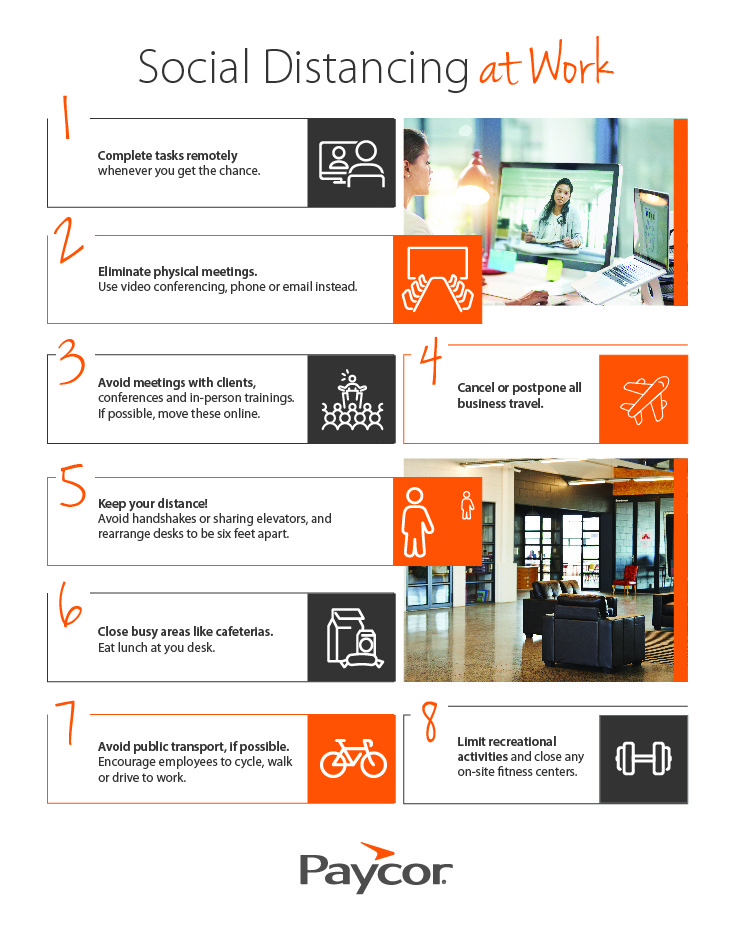To protect communities during the current public health crisis, the White House has advised all businesses to allow employees to work from home whenever they can. However, there are plenty of industries—often providing essential services—where this just isn’t possible.
It’s the responsibility of every employer to create a safe work environment for employees who continue traveling to work—and social distancing should play a big part of this. By following best practices, businesses can keep their employees (and communities) safe without sacrificing productivity.
What is Social Distancing?
Social distancing is all about avoiding unnecessary physical closeness with others, whenever possible. It’s important because, according to the CDC, the Coronavirus is thought to spread in two main ways:
- Between people who are within around 6 feet of each other
- By droplets produced by coughs and sneezes
While virus may be able to live on surfaces, the evidence is clear: if you stay 6 feet away from people as much as possible, you are far less likely to get infected. The big problem is, anybody could be sick but not know it yet. That’s why everybody should practice social distancing even if they don’t feel unwell.
If employees are reluctant to follow these rules, remind them: it’s not just about your own health, but the health of the people you might pass the virus on to. Everybody—and every business—has a part to play in slowing down the spread as much as possible.

Social Distancing in the Workplace: What You Need To Know
There are a lot of steps that companies can take to effectively prevent the spread of Coronavirus in the workplace.
- Keep Distance
Whenever possible, employees should stay 6 feet away from each other. Try rearranging desks to make use of all the space you have available. Remember to avoid shared rides in the elevator!
- No Physical Greetings
Though this may seem obvious, it can be tough to get rid of old habits: no hugs, handshakes or kisses on the cheek. Don’t forget to say hello—but now’s the time to stick to a wave.
- Identify Danger Zones
Think about the places where people are often close together, like a cafeteria or reception area. Either close these off (we recommend employees have lunch at their own desks) or limit the number of people allowed in a room at the same time.
- Limit Customer Interaction
If you can delay (or move online) any meetings with clients, do. If you work in a customer-facing environment, try to make sure any interactions happen at a safe distance. Make sure any lines are spaced out, even if that means people have to wait outside.
- Eliminate Meetings
Even if you can’t work remotely, you can still hold meetings online. It’s also better to avoid wandering over to a colleague’s desk just to check in—shoot them an email instead.
- Think of Anything That Can be Done Remotely
When it comes to social distancing at work, every little helps. If you can think of just one task that can be done from home, you’re reducing the number of employees in the building at one time and making it easier for everyone to keep their distance.
- Limit Extra Activities
Team get-togethers like pick-up basketball games or happy hours can be great for engagement, but now’s the time to postpone for a while. Remembering social distancing rules is especially hard at the end of a tough day—it’s easier to avoid any risks completely.
- Avoid Public Transport
Social distancing isn’t just about what happens in the workplace, it’s also about how you get there. If there’s any way for employees to get to work without cramming into a bus or train, think of ways to make it happen. For essential workers, consider offering a stipend for taxi rides.
- Get Your Scheduling Right
Try to optimize your schedules so that you have the minimal number of employees present. This can be tricky, especially when there’s a higher risk of no-shows and late call-offs due to sickness. Finally, if you’re still posting schedules on the wall of the staff room—now’s the time to change.
How Paycor Can Help
Paycor Scheduling gives SMBs the technology they need to create efficient schedules, distribute them electronically and react quickly to schedule changes. To learn more, talk to a member of our sales team.
Share this Image On Your Site
Next:
9 Ways to Manage Costs








